Chapter: Operations Research: An Introduction : Transportation Model and Its Variants
Nontraditional Transportation Models
NONTRADITIONAL
TRANSPORTATION MODELS
The application of the transportation model is not limited to transporting commodities between
geographical sources and destinations. This section presents two applications
in the areas of production-inventory control and tool sharpening service.
Example 5.2-1
(Production-Inventory Control)
Boralis
manufactures backpacks for serious hikers. The demand for its product occurs
during March to June of each year. Boralis estimates the demand for the four
months to be 100, 200, 180, and 300 units, respectively. The company uses
part-time labor to manufacture the backpacks and, accordingly, its production
capacity varies monthly. It is
estimated that Boralis can produce 50, 180,280, and 270 units in March through
June. Because the production capacity and demand for the different months do
not match, a current month's demand may be satisfied in one of three ways.
a)
Current month's production.
b)
Surplus production in an earlier month.
c)
Surplus production in a later month (backordering).
In the
first case, the production cost per backpack is $40. The second case incurs an
additional holding cost of $.50 per backpack per month. In the third case, an
additional penalty cost of $2.00 per backpack is incurred for each month delay.
Boralis wishes to determine the optimal production schedule for the four
months.
The
situation can be modeled as a transportation model by recognizing the following
parallels between the elements of the production-inventory problem and the
transportation model:
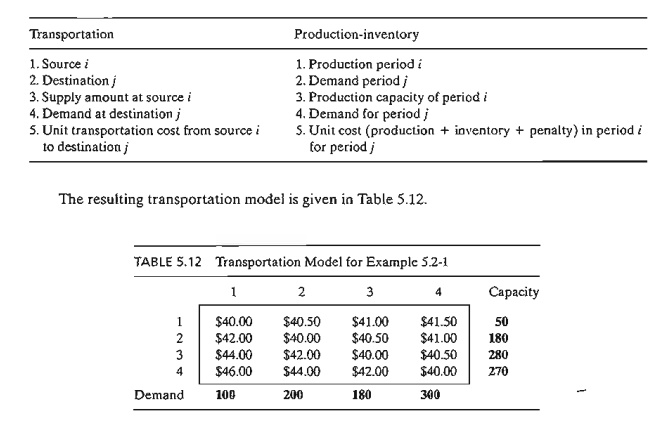
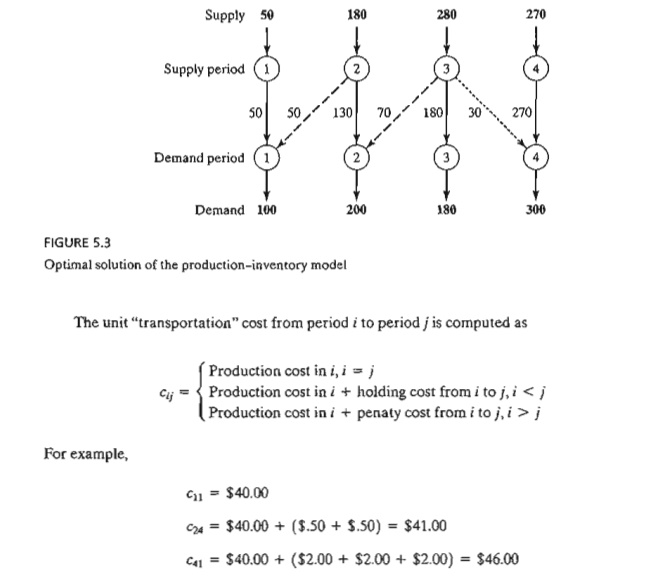
The
optimal solution is summarized in Figure 5.3. The dashed lines indicate
back-ordering, the dotted lines indicate production for a future period, and
the solid lines show production in a period for itself. The total cost is
$31,455.
Example 5.2-2 (Tool Sharpening)
Arkansas
Pacific operates a medium-sized saw mill. The mill prepares different types of
wood that range from soft pine to hard oak according to a weekly schedule.
Depending on the type of wood being milled, the demand for sharp blades varies
from day to day according to the follow-ing I-week (7-day) data:

The mill
can satisfy the daily demand in the following manner:
a)
Buy new blades at the cost of $12 a blade.
b)
Use an overnight sharpening service at the cost of
$6 a blade.
c)
Use a slow 2-day sharpening service at the cost of
$3 a blade.
The
situation can be represented as a transportation model with eight sources and
seven destinations. The destinations represent the 7 days of the week. The sources of
the model are defined as follows: Source 1
corresponds to buying new blades, which, in the extreme case, can provide
sufficient supply to cover the demand for all 7 days (= 24 + 12 + 14 + 20 + 18 + 14 + 22 = 124). Sources 2 to 8 correspond to the 7 days of the week. The amount of
supply for each of these sources equals the number of used blades at the end of
the associated day. For ex-ample, source 2 (i.e., Monday) will have a supply of
used blades equal to the demand for Mon-day. The unit "transportation
cost" for the model is $12, $6, or $3, depending on whether the blade is
supplied from new blades, overnight sharpening, or 2-day sharpening. Notice
that the overnight service means that used blades sent at the end of day i will be available for use at the start of day i + 1 or day i + 2, because the slow 2-day service
will not be available until the start of
day i + 3. The "disposal" column is a
dummy destination needed to balance the model. The com-plete model and its
solution are given in Table 5.13.

The
problem has alternative optima at a cost of $840 (file toraExS.2-2.txt).The
following table summarizes one such solution.
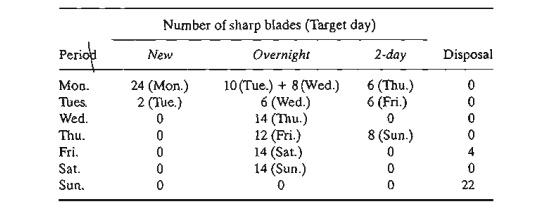
Remarks. The model in Table 5.13 is
suitable only for the first week of operation because it does not take into
account the rotational nature of the
days of the week, in the sense that this week's days can act as sources for
next week's demand. One way to handle this situation is to assume that the very
first week of operation starts with all new blades for each day. From then on,
we use a model consisting of exactly 7 sources and 7 destinations corresponding
to the days of the week. The new model will be similar to Table 5.13 less source
"New" and destination "Disposal." Also, only diagonal cells
will be blocked (unit cost = M). The remaining cells will have a unit
cost of either $3.00 or $6.00. For example, the unit cost for cell (Sat., Mon.)
is $6.00 and that for cells (Sat., Tue.), (Sat., Wed.), (Sat., Thu.), and
(Sat., Fri.) is $3.00. The table below gives the solution costing $372. As
expected, the optimum solution will always use the 2-day service only. The
problem has alternative optima (see file toraEx5.2-2a.txt).
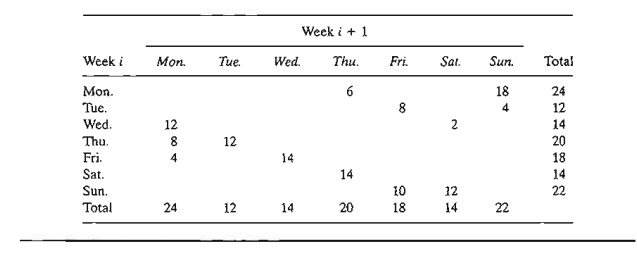
PROBLEM SET S.2A
1. In Example 5.2-1, suppose that the holding cost per unit is
period-dependent and is given by 40, 30, and 70 cents for periods 1,2, and 3,
respectively. The penalty and production costs I'emain as given in the example.
Determine the optimum solution and interpret the results.
*2. In Example 5.2-2, suppose that the sharpening service offers 3-day
service for $1 a blade on Monday and Tuesday (days 1 and 2). Reformulate the
problem, and interpret the opti-mum solution.
3. In Example 5.2-2, if a blade is not used the day it is sharpened, a
holding cost of 50 cents per blade per day is incurred. Reformulate the model,
and interpret the optimum solution.
4. JoShop wants to assign four different categories of machines to five
types of tasks. The numbers of machines available in the four categories are
25, 30,20, and 30. The numbers of jobs in the five tasks are 20, 20, 30,10, and
25. Machine category 4 cannot be assigned to task type 4. Table 5.14 provides
the unit cost (in dollars) of assigning a machine cate-gory to a task type. The
objective of the problem is to determine the optimum number of machines in each
category to be assigned to each task type. Solve the problem and inter-pret the
solution.
*5. The demand for a perishable item over the next four months is
400,300,420, and 380 tons, respectively. The supply capacities for the same
months are 500, 600, 200, and 300 tons. The purchase price per ton varies from
month to month and is estimated at $100, $140, $120, and $150, respectively.
Because the item is perishable, a current month's sup-ply must be consumed
within 3 months (starting with current month). The storage cost per ton per
month is $3. The nature of the item does not allow back-ordering, Solve the
problem as a transportation model and determine the optimum delivery schedule
for the item over the next 4 months.
6. The demand for a special small engine over the next five quarters is
200, 150, 300,250, and 400 units. The manufacturer supplying the engine has
different production capacities estimated at 180,230,430,300, and 300 for the
five quarters. Back-ordering is not al-lowed, but the manufacturer may use
overtime to fill the immediate demand, if necessary. The overtime capacity for
each period is half the regular capacity. The production costs per unit for the
five periods are $100, $96, $116, $102, and $106, respectively. TIle over-time
production cost per engine is 50% higher than the regular production cost. If an en-gine is produced now for use in later
periods, an additional storage cost of $4 per engine per period is incurred.
Formulate the problem as a transportation model. Determine the optimum number
of engines to be produced during regular time and overtime of each period.
7. Periodic preventive maintenance is carried out on aircraft engines,
where an important component must be replaced. The numbers of aircraft
scheduled for such maintenance over the next six months are estimated at 200,
180,300,198,230, and 290, respectively. All maintenance work is done during the
first day of the month, where a used component may be replaced with a new or an
overhauled component. The overhauling of used com-ponents may be done in a
local repair facility, where they will be ready for use at the be-ginning of
next month, or they may be sent to a central repair shop, where a delay of
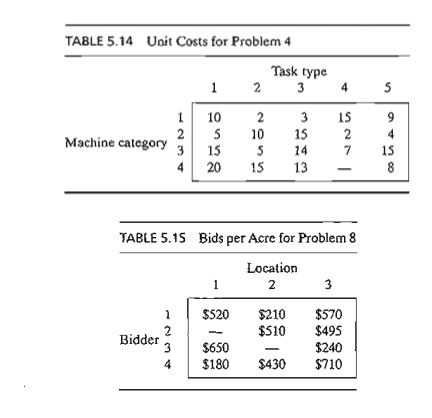
3 months (including the month in which maintenance occurs) is expected.
The repair cost in the local shop is $120 per component. At the central
facility, the cost is only $35 per component. An overhauled component used in a
later month will incur an additional storage cost of $1.50 per unit per month. New
components may be purchased at $200 each in month 1, with a 5% price increase
every 2 months. Formulate the problem as a transportation model, and determine
the optimal schedule for satisfying the demand for the component over the next
six months.
8. The National Parks Service is receiving four bids for logging at
three pine forests in Arkansas. The three locations include 10,000,20,000, and
30,000 acres. A single bidder can bid for at most 50% of the total acreage
available. The bids per acre at the three locations are given in Table 5.15.
Bidder 2 does not wish to bid on location I, and bidder 3 cannot bid on
location 2.
a. In the present situation, we need to maximize the total bidding revenue for the Parks Service. Show how
the problem can be formulated as a transportation model.
b. Determine the acreage that should be assigned to each of the four
bidders.
Related Topics